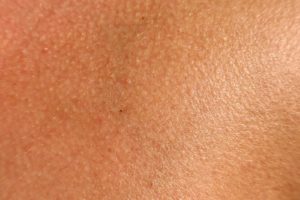 The microbes living on healthy human skin include bacteria, fungi, and viruses...but 90% of the viruses found on healthy skin in this study are unknown to researchers - thus "viral "dark matter". The skin virome is the population of viruses on the skin. It turns out that most of the viruses on healthy skin are phage viruses. called bacteriophages.They infect bacteria and may take up residence within bacteria. From Science Daily:
The microbes living on healthy human skin include bacteria, fungi, and viruses...but 90% of the viruses found on healthy skin in this study are unknown to researchers - thus "viral "dark matter". The skin virome is the population of viruses on the skin. It turns out that most of the viruses on healthy skin are phage viruses. called bacteriophages.They infect bacteria and may take up residence within bacteria. From Science Daily:
90 percent of skin-based viruses represent viral 'dark matter,' scientists reveal
Scientists in recent years have made great progress in characterizing the bacterial population that normally lives on human skin and contributes to health and disease. Now researchers from the Perelman School of Medicine at the University of Pennsylvania have used state-of-the-art techniques to survey the skin's virus population, or "virome." The study, published in the online journal mBio last month, reveals that most DNA viruses on healthy human skin are viral "dark matter" that have never been described before. The research also includes the development of a set of virome analysis tools that are now available to researchers for further investigations.
Researchers and the public are increasingly aware that microbes living on and inside us -- our "microbiomes" -- can be crucial in maintaining good health, or in causing disease. Skin-resident bacteria are no exception. Ideally they help ward off harmful infections, and maintain proper skin immunity and wound-healing, but under certain circumstances they can do the opposite.
"Until now, relatively little work has been done in this area, in part because of the technical challenges involved. For example, a skin swab taken for analysis will contain mostly human and bacterial DNA, and only a tiny amount of viral genetic material -- the proverbial needles in the haystack."
Their analysis of samples from 16 healthy individuals revealed some results that were expected. The most abundant skin-cell infecting virus was human papilloma virus, which causes common warts and has been linked to skin cancers. However, most of the detected DNA from the VLPs did not match viral genes in existing databases. "More than 90 percent was what we call viral dark matter -- it had features of viral genetic material but no taxonomic classification," Grice said. That came as a surprise, although of course it highlighted the importance of mapping this unexplored territory.
The findings also clearly linked the skin virome to the skin microbiome: Most of the detected viral DNA appeared to belong to phage viruses, which infect and often take up long-term residence within bacteria. And when Grice and colleagues sequenced skin bacterial DNA from the same 16 subjects, they found that it often contained tell-tale marks -- called CRISPR spacers -- of prior invasion by the same phage viruses.
The results also showed that the skin virome varies considerably depending on the body site. Grice's team took swabs from the palm, the forehead, the armpit, the navel, and other sites, and found, for example, that the virome was most diverse in the crook of the arm, a site that is intermittently exposed and occluded.
